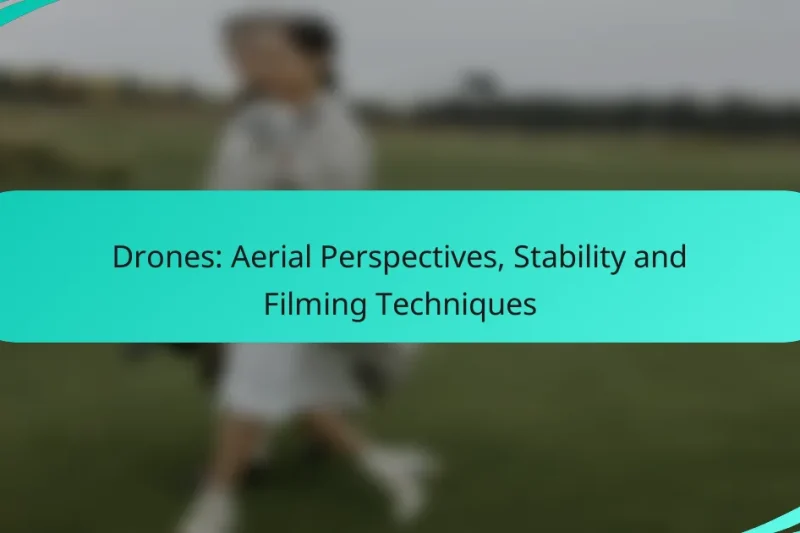Slow motion is a powerful tool in filmmaking that enhances viewer engagement by allowing audiences to … Slow Motion: Impact, Timing and Viewer EngagementRead more
Extreme Sports Documentary Production: Capturing Authentic Action
Extreme sports documentaries require meticulous planning and specialized equipment to authentically capture the adrenaline and excitement of the action. By selecting the right gear and employing effective filming techniques, filmmakers can showcase the unique landscapes and vibrant cultures surrounding these thrilling activities. Immersing oneself in the athletes’ experiences is essential to convey their motivations and journeys, ensuring a genuine representation of the extreme sports world.
Drones: Aerial Perspectives, Stability and Filming Techniques
Drones have revolutionized the way filmmakers capture aerial perspectives, offering unique vantage points that enhance storytelling … Drones: Aerial Perspectives, Stability and Filming TechniquesRead more
Editing Techniques: Thrill Conveyance, Pacing and Audience Connection
Editing techniques are essential for enhancing the thrill and emotional engagement in films, as they manipulate … Editing Techniques: Thrill Conveyance, Pacing and Audience ConnectionRead more
POV Shots: Engagement, Perspective and Narrative Depth
POV shots are a powerful cinematic technique that enhances viewer engagement by allowing audiences to experience … POV Shots: Engagement, Perspective and Narrative DepthRead more
GoPro vs. DSLR: Which Is Better and When to Use
When deciding between a GoPro and a DSLR, it’s essential to consider the specific needs of … GoPro vs. DSLR: Which Is Better and When to UseRead more
How to produce extreme sports documentaries in the USA?
Producing extreme sports documentaries in the USA involves careful planning, specialized equipment, and a keen understanding of the action being filmed. Key factors include selecting the right gear, employing effective filming techniques, and utilizing editing styles that amplify the excitement of the sport.
Equipment selection for action filming
Choosing the right equipment is crucial for capturing the intensity of extreme sports. Cameras should be lightweight and capable of high frame rates, with options like GoPros or DSLRs being popular choices. Stabilizers and gimbals help ensure smooth footage, especially during fast-paced action.
Additionally, consider using drones for aerial shots, which can provide unique perspectives on the action. Ensure that all equipment is weather-resistant, as extreme sports often take place in challenging environments.
Filming techniques for dynamic scenes
Effective filming techniques are essential for conveying the thrill of extreme sports. Use a mix of wide shots to establish the environment and close-ups to capture the athletes’ expressions and movements. Tracking shots, where the camera follows the action, can create a sense of immersion.
Utilizing slow motion can emphasize key moments, allowing viewers to appreciate the skill involved. Always be mindful of safety; ensure that camera operators are positioned in safe locations while still capturing the action effectively.
Editing styles that enhance adrenaline
Editing plays a pivotal role in building excitement in extreme sports documentaries. Fast cuts and dynamic transitions can heighten the sense of urgency and thrill. Syncing the footage with an energetic soundtrack can further amplify the adrenaline rush for viewers.
Incorporating graphics, such as speed indicators or athlete profiles, can provide context and enhance viewer engagement. However, avoid overusing effects that may distract from the action; the focus should remain on the athletes and their performances.
What are the best locations for extreme sports filming?
The best locations for extreme sports filming are those that offer unique landscapes, challenging conditions, and a vibrant culture surrounding the sport. Key factors to consider include accessibility, local regulations, and the availability of experienced athletes to showcase the action.
Top US locations for snowboarding documentaries
Some of the premier locations for snowboarding documentaries in the US include Jackson Hole, Wyoming, and Mammoth Mountain, California. These areas provide stunning backdrops and varied terrain, making them ideal for capturing thrilling snowboarding action.
When filming in these locations, consider the seasonal weather patterns and snow conditions. Winter months typically offer the best snow, but be prepared for fluctuating temperatures and potential storms that can affect visibility and safety.
Best beaches for surfing documentaries
For surfing documentaries, iconic beaches like Pipeline in Hawaii and Malibu in California stand out. These spots are renowned for their powerful waves and picturesque settings, attracting surfers from around the globe.
When selecting a beach for filming, pay attention to tide schedules and swell forecasts, as these can significantly impact wave quality. Additionally, ensure you have the necessary permits to film in these popular areas, as regulations can vary by location.
How to capture authentic athlete experiences?
Capturing authentic athlete experiences involves immersing yourself in their world, understanding their motivations, and documenting their journeys. This approach ensures that the documentary reflects the true essence of extreme sports and the individuals who pursue them.
Interview techniques for genuine storytelling
To achieve genuine storytelling in interviews, use open-ended questions that encourage athletes to share their personal narratives. Questions like “What drives you to push your limits?” can elicit deeper insights than simple yes or no inquiries.
Active listening is crucial; show genuine interest in their responses and ask follow-up questions that delve deeper into their experiences. This technique not only builds trust but also enriches the narrative with authentic details.
Building rapport with extreme sports athletes
Building rapport with extreme sports athletes requires patience and respect for their craft. Engage with them before filming to establish a connection, perhaps by participating in a training session or attending an event together.
Understanding their unique challenges and achievements fosters a sense of camaraderie. Acknowledge their expertise and share your enthusiasm for their sport, which can lead to more candid conversations and a more authentic portrayal in your documentary.
What are the key challenges in extreme sports documentary production?
Extreme sports documentary production faces several key challenges, including safety concerns, unpredictable weather, and the need for specialized equipment. Filmmakers must navigate these issues to capture authentic action while ensuring the well-being of everyone involved.
Safety concerns during filming
Safety is paramount in extreme sports documentary production. Filmmakers must assess risks associated with the sport being filmed, such as potential injuries from falls or equipment failures. It’s essential to have safety protocols in place, including the use of protective gear and emergency response plans.
Collaboration with experienced athletes and safety experts can enhance overall safety. For instance, having a qualified medic on-site during shoots can provide immediate assistance in case of accidents. Additionally, conducting thorough risk assessments before filming can help identify and mitigate potential hazards.
Weather conditions affecting shoots
Weather conditions significantly impact extreme sports filming, as they can change rapidly and affect both safety and visibility. Filmmakers should monitor forecasts closely and be prepared to adjust schedules or locations accordingly. For example, heavy rain or strong winds can make certain activities dangerous or impossible to film.
Planning for various weather scenarios is crucial. Having backup locations or alternative shooting days can help maintain production timelines. Filmmakers should also consider the best times of year for specific sports, as conditions can vary widely by season, influencing both safety and the quality of the footage captured.
How to market extreme sports documentaries?
Marketing extreme sports documentaries involves leveraging niche audiences and unique platforms to reach enthusiasts. Effective strategies include utilizing social media, collaborating with brands, and engaging with communities that share a passion for extreme sports.
Utilizing social media for promotion
Social media is a powerful tool for promoting extreme sports documentaries, as it allows direct engagement with audiences. Platforms like Instagram, TikTok, and YouTube are ideal for sharing trailers, behind-the-scenes content, and athlete interviews, creating buzz around the release.
Consider using targeted ads to reach specific demographics interested in extreme sports. Engaging with followers through live Q&A sessions or interactive posts can also enhance visibility and foster a community around the documentary.
Collaborating with extreme sports brands
Partnering with extreme sports brands can amplify the reach of your documentary. Brands often have established audiences and marketing resources that can be leveraged for mutual benefit. Collaborations might include co-branded content, sponsorships, or promotional events.
When approaching brands, focus on those whose values align with the documentary’s themes. For example, a film about snowboarding could partner with a leading snowboard manufacturer for cross-promotion, creating authentic connections with potential viewers.
What are the emerging trends in extreme sports documentaries?
Emerging trends in extreme sports documentaries focus on enhancing viewer engagement through innovative technologies and storytelling methods. These trends include the use of virtual reality and interactive storytelling techniques that create immersive experiences for audiences.
Virtual reality experiences
Virtual reality (VR) experiences in extreme sports documentaries allow viewers to feel as if they are part of the action. By using VR headsets, audiences can immerse themselves in thrilling environments, such as soaring through the air while skydiving or navigating treacherous mountain trails during a downhill bike race.
Filmmakers should consider the technical requirements for VR production, including high-resolution cameras and specialized editing software. Additionally, creating a seamless experience often involves capturing 360-degree footage to provide a comprehensive view of the action.
Interactive storytelling techniques
Interactive storytelling techniques enable viewers to influence the narrative of extreme sports documentaries. This can involve choices that affect the storyline, such as selecting different athletes to follow or choosing specific events to explore in-depth.
To effectively implement interactive elements, filmmakers can use platforms that support branching narratives. It’s essential to balance interactivity with coherent storytelling to ensure that viewers remain engaged without feeling overwhelmed by options.
How to secure funding for extreme sports documentaries?
Securing funding for extreme sports documentaries often involves a mix of traditional and innovative approaches. Filmmakers can seek grants, sponsorships, crowdfunding, and partnerships to finance their projects.
Explore grant opportunities
Many organizations and foundations offer grants specifically for documentary filmmaking. Research local and international grants that focus on sports, adventure, or cultural storytelling. Examples include the Sundance Documentary Fund and the International Documentary Association.
When applying for grants, tailor your proposal to highlight the unique aspects of your extreme sports documentary. Emphasize the cultural significance, potential audience engagement, and how your film aligns with the funder’s mission.
Seek sponsorships from brands
Brands related to extreme sports, such as equipment manufacturers or energy drink companies, may be interested in sponsoring your documentary. Approach them with a clear proposal that outlines the benefits of associating their brand with your film, such as exposure to a targeted audience.
Consider offering promotional opportunities, such as logo placement in the film or on promotional materials, to make the sponsorship more appealing. Building a strong relationship with potential sponsors can lead to long-term partnerships.
Utilize crowdfunding platforms
Crowdfunding can be an effective way to raise funds for your extreme sports documentary. Platforms like Kickstarter or Indiegogo allow filmmakers to present their projects and attract small contributions from a large audience.
To succeed in crowdfunding, create a compelling campaign that includes a captivating video pitch, detailed project description, and attractive rewards for backers. Promote your campaign through social media and relevant communities to reach potential supporters.
Consider partnerships with production companies
Partnering with established production companies can provide access to additional funding and resources. Look for companies that have experience in extreme sports or documentary filmmaking and propose a collaboration that benefits both parties.
When forming partnerships, clearly define roles, responsibilities, and financial contributions to ensure a smooth working relationship. A well-structured partnership can enhance the quality of your documentary and increase its chances of success.




